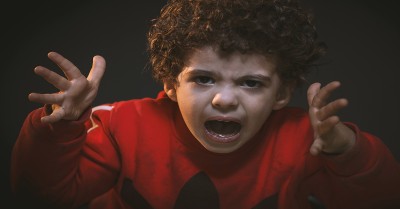Anger is an emotion that we all feel that is a natural response to certain situations or even people. Temper is associated with yelling, hitting, acting out, throwing things caused by the feeling of anger. It's important for children to understand that feeling anger is completely normal and for those children with a temper we need to provide them with tools in order for them to manage it appropriately.
One way of teaching children to take control of their temper with Temper Monsters.
Temper Monster
Using the metaphor of a Temper Monster children can learn how to be the boss of their temper:
- Talk with children about tempers. For example: Feeling angry, What is a temper, What happens when you feel angry, what happens a temper takes control.
- Tell children that you know a great way to help them to be the boss of their temper. Be enthusiastic and encouraging.
- Start by drawing a small temper monster . Describe what it looks like (eg lots of sharp spikes, long arms and legs for throwing and kicking, fire breathing) and the colour of your temper (eg red hot, black, all different colours).
- Talk about the things that can make feel angry and their temper get very big and may become the boss of each child. For instance, when a friend doesn't share, wanting something you can't have, feeling very tired or hungry, being ignored etc.
- Discuss how the body changes when you start feeling more angry such as feeling hot, heart beating fast, throwing something or shouting.
- Explain to children that although these feel “uncomfortable”, they can be helpful too, as they are signs that the temper is getting bigger and becoming the boss.
- On a larger piece of paper, draw the temper monster when it is really big and the becoming the boss. Once again describe how the body feels that make the temper get bigger and bigger inside you. This can help make the concept of the temper monster more concrete and understandable.
- Encourage the children to talk about what makes their temper become the boss. Give examples of incidents that may make children feel angry.
- Ask children to draw a picture of what their temper monster looks like when it becomes the boss of them. Let each child describe their own temper monster.
- Discuss different ways of containing their temper to stop it from getting too big and becoming the boss. This could include putting in a jar that is locked.
- Give each child a jar and have them on displayed on a shelf that children can visually see and access when necessary. Each jar could have the child's name on it and inside the child adds their drawing of their temper monster. Once the child adds their temper monster into their jar tie a ribbon around it so it represents that it is locked away.
On any day if a child starts to feel angry and that they start losing their temper by shouting, throwing things or hitting another child, first encourage the child to try a technique to gain control (such as taking a deep breath), then take the child to find their jar and check that their temper monster is still locked inside the jar and that it hasn't escaped.
This is an important step as it can serve as a distraction from the incident and be a reinforcement for the child that they have control.
Remember to positively encourage any attempts a child makes to control their temper. Discuss what they did, how it worked, how they felt, what they would do next time and so on. Remind the child again of the procedure for keeping their temper under control and praise their increasing skill at temper control. This can be used as a whole group exercise or for a specific child.
It's important to encourage children to express their anger appropriately and when they are feeling like losing control that they have a safe place within the environment that they can go and cool off or provide them with items in a calm don box to support them to take control and release their temper in an appropriate way.
Reference:
Supporting and Managing Children's Behaviour, Department Of Education and Children's Services
